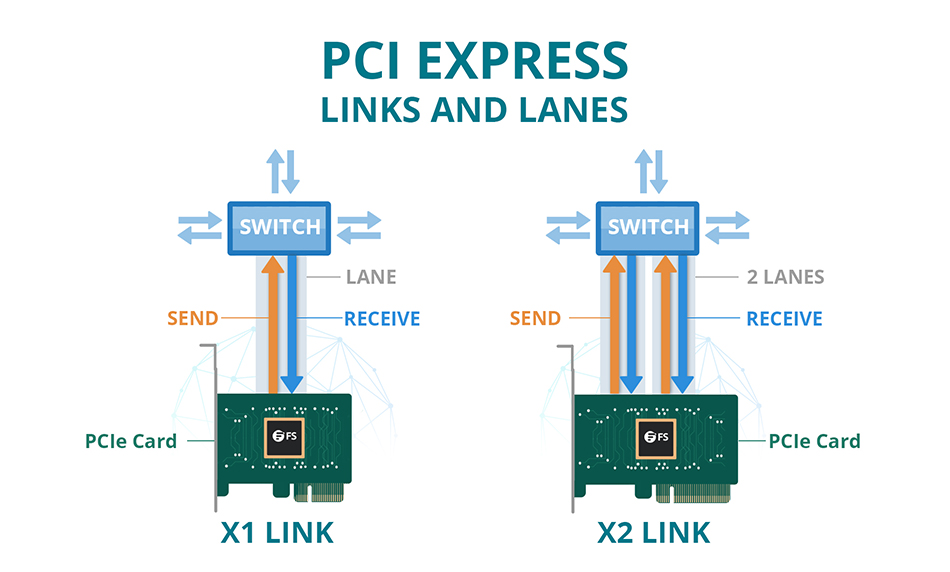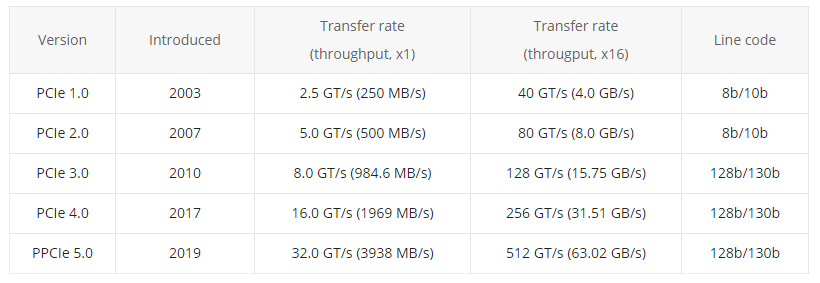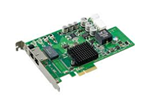What is a PCIe Expansion Slot?
PCI Express (PCIe) is a standard interface that connects peripheral components or add-on cards to the motherboard. PCIe can also be described as a standard for connecting devices to computers. The internal structural design of PCIe is a lot like a local area network in that each link goes a central hub in the computer that performs network-like switching. PCIe slots can be used to add GPU cards, RAID cards, Wi-Fi cards, and SSD cards.
How does PCIe Cards Work?
When the PCIe card is installed, a connection or link is formed between the PCIe device and the system. The link is constructed around a bi-directional serial point-to-point connection called a “lane”. A link can use more than one lane at a time by all links compliant with the PCIe specification, but must minimally support single-lane connections, known as “x1” links. For greater potential bandwidth, PCIe devices and systems have the option to support links using multiple simultaneous lanes- for example; an “x16” link uses 16 lanes. To be able to support the extra lanes, a PCIe card and slot have to be designed to coordinate the extra electrical lines required which is 2 lines per lane.

What are the different types of PCIe Formats?
The size of PCIe cards is determined by the number of lanes. There are four PCIe sizes: x1, x4, x8, and x16. The number "x" refers to how many lanes there are in a PCIe slot. For example, a PCIe x 16 means that the card slot has 16 lanes. PCIe cards can physically fit into slots that are designed for their lane configuration or higher (up-plugging), but will not fit into slots designed for lower lane configurations (down-plugging). For instance, an x1 card will fit into x1, x4, x8, and x16 but an x16 card will only fit into an x16 slot. An x1 card in any compliant PCIe slot will always run in x1 mode.

PCIe Versions and Transfer Rates
Currently, there are five different versions of PCIe: PCIe 1.0, PCIe 2.0, PCIe 3.0, PCIe 4.0, and PCIe 5.0. PCIe 1.0 was first introduced in 2003 and the most recent version, PCIe 5.0, was released in 2019. PCIe 6.0 is expected to release in 2021.

PCIe Application
PCIe, PCI Express, introduced lately as a standard for connecting devices to computers. The software is compatible with PCI but has greater potential bandwidth and larger flexibility than PCI. PCI-SIG manages the PCIe specification as well. Because the two standards share a mutual foundation, the majority of the new computers support PCIe and PCI for more compatibility. PCIe can be used for internal Wi-Fi cards, 10 Gigabit Ethernet cards, hard drives, and Solid State Drives (SSDs). PCIe slots can also support AI accelerator cards, such as FPGA card, vision process card (VPU), and graphics process card (GPU) for intelligent and deep learning applications.
Why use PCIe slots?
The internal structural design of PCIe is a lot like a local area network in that each link goes a central hub in the computer that performs network-like switching. This is a contrast to the PCI architecture whereas all devices share the same unidirectional, parallel bus. Because PCIe slots are not based on parallel connections that can be hindered by timing issues, PCIe slots allow data to be easily transmitted over long distances and are more reliable and cost-effective.
Sources: Lifewire & FS / Images from FS
About Acnodes Corporation
Acnodes supplies and markets industrial computers and display solutions for diverse industries ranging from automation to the military. They have an array of technological innovations in the area of rackmount servers, embedded computers, Panel PCs, and rugged monitors that created more simple and valuable products to the customers. Acnodes works closely with their clients to customize computer products to meet required projects and specifications. Acnodes strives to explore new technologies to better improve life and work.





